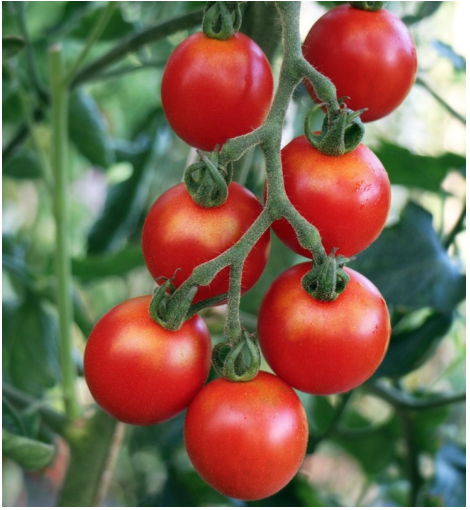Crop: Solanum lycopersicum L. (Tomato)
The landrace called ‘Máriapócs’ originates from Máriapócs (Hungary) and it was collected by the Centre for Plant Diversity in 1983.
Máriapócs is an indeterminate, vigorous and productive, relatively early landrace, with red round berries (apporox. 15-20 g) and with 15-18 berries/cluster. It flowers in June and it ripens from early July, with a peak in middle August. The landrace is best consumed fresh, in salads or as a snack. Although the clusters are not ripening completely uniformly, they can be harvested as a cluster. The landrace is reasonably uniform, tolerant to fungal diseases, has a good foliage regeneration ability, constant production (till the end of October) and does not develop symptoms of magnesium or calcium deficiency. Continuous rain might have a negative effect on the taste. (Cseperkálóné et al 2017).
Cultivation System: suitable for low-input conditions, organic cultivation.
Geographical Information
Country: Hungary
Máriapócs was traditionally cultivated in the backyard gardens of the village Máriapócs North-East part of Hungary). The landrace is abandoned in the region of origin. The National Gene Bank (Centre for Plant Diversity www.nodik.hu) preserved this landrace, which was collected by them in 1983. The Hungarian Research Institute of Organic Agriculture (ÖMKi) requested accessions from the Centre for Plant Diversity in order to carry out on-farm participatory experiments between 2012-2016, comparing tomato landraces (including Máriapócs) in five growing seasons in Hungary. In 2018 citizens could ‘adopt’ a seedling choosing from 6 varieties and in 2019 the seedlings of 3 varieties (including Máriapócs) out of the aforementioned 6 were available in a supermarket. Nowadays it is cultivated by several farmers and hobby gardeners all over the country.
Farmer(s) description:
Farmers and hobby gardeners are growing nowadays the landrace in backyard gardens, organic farms, out of its region of origin, scattered all over the county.
Propagation system: Seed, self-pollination
Multiplication procedures and consequences on landrace diversity:Tomato is a predominantly self-pollinating plant, but crosses do occur where presence of insects is high. Each farmer multiplies his own seed under slightly different agronomic conditions. The average number of plants multiplied by each farmer each year ranges from a few to several hundreds. At harvesting, each farmer selects seeds that will be used for the following season.
Management plan existence:No support is provided by local authorities.
Added Values
If there is any market for this landrace, at the moment is very small, it’s mainly grown for own consumption.
Others (e.g. commercial/geographical brands or special traits):‘Máriapócs’ is registered as conservation variety in the European Common Catalogue of Conservation Varieties following the Commission Directive 2008/62/CE of 20 June 2008.
The Hungarian Research Institute of Organic Agriculture (ÖMKi) launched a participatory research on the usability of Hungarian tomato landraces on organic farms in 2012. The aim of the analysis was to reintroduce landraces that were the most suitable for organic production into Hungarian gardens so that their special and diverse colour, shapes and flavours could be rediscovered. In order to make seeds and seedlings available for a wider public, after a precise description ÖMKi registered the most popular and successful 6 landraces in 2019 and support the seedling production in the frame of the campaign ‘From research to plate’.
Accessions of ‘Máriapócs’ are kept, under long terms storage conditions in the germplasm bank of the Centre for Plant Diversity, Hungary.
The landrace is maintained since 2012 on-farm beyond and as part of the ÖMKi landrace tomato project
Centre for Plant Diversity www.nodik.hu
Limited number of seedlings are available in the LiDL supermarket since 2019.
Case study prepared by The Hungarian Research Institute of Organic Agriculture (ÖMKi), Hungary.
- https://secure.caes.uga.edu/extension/publications/files/pdf/B%201312_6.PDF
- Cseperkálóné Mirek B., Dr. Drexler D., Papp O. (2017) Paradicsom tájfajták vizsgálata ökológiai gazdálkodásban
